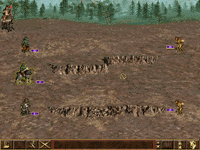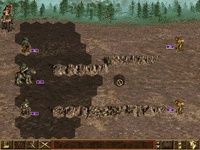This is not to train you in tactics and strategy, but it will help you understand how a round of combat works if you are one of the new recruits. Once you understand how battles are fought, you will be ready for more advanced training.
Before You Start
Before you start, I recommend going into Combat Options (the left-most button on the combat screen) and turn View Hex Grid, Movement Shadow, and Cursor Shadow on, because it helps you understand what's going on. I also suggest turning the animation speed to medium (the middle option) because it gets real dull watching the animations running at the default slow speed.
Notice in the first picture it is difficult to tell how far you can move. In the second picture, the Movement Shadow makes it perfectly clear where the Wolf Riders can move by highlighting the hexes they can move into. I really don't know why that is not turned on by default. The third picture shows the Hex Grid. I personally don't play with it turned on, but it may be helpful when you are starting out, and it makes it easier to count the distance between creatures.
Combat
Combat begins with the tactics phase. In the tactics phase, the hero with the highest level in the tactics skill gets to arrange his troops before the battle begins. If neither hero has the tactics skill, or if both heroes have the same level in the skill, this phase is skipped. The tactics phase does not happen again.
After tactics, the first round of combat begins. A round of combat is made up of four phases.
- Siege
- First Movement
- War Machines
- Second Movement
The siege phase only happens during siege combat (attacking or defending a castle). During the siege phase, a castle's arrow towers will shoot at the attackers, and the attacker's catapult will attempt to damage the castle walls. If the defender has the Artillery secondary skill, he can pick which creatures to shoot with the arrow towers (this works in Heroes III Complete only). If the attacker has the Ballistics secondary skill, he can pick which sections of the castle wall will be attacked with the catapult.
In the first movement phase, each creature in the battle gets a turn starting with the fastest creature. If there's a speed tie among one player's creatures, the one closest to the top of the screen wins it. If there's a speed tie between two players, the attacker wins the tie if it's the start of the battle, or the player who last moved a creature loses the tie if it's in the middle of the battle.
When it is a creature's turn, it may do one of the following.
- Move
- Wait
- Defend
- Special Ability
- Ranged Attack
- Melee Attack
After the first movement phase, the war machines phase begins. In the war machines phase, Ballistas and Healing Tents take their actions. A ballista will shoot an enemy creature, and a healing tent will heal a creature. This phase is skipped if neither side has a healing tent or ballista. The computer picks the creatures to be shot/healed for ballistas/healing tents unless the heroes have the artillery/healing secondary skills.
In the second movement phase, all creatures that chose to Wait during the first movement phase take a turn. The order is slowest to fastest.
After the second movement phase, the current round of combat is over and another round begins. Combat does not end until all creatures on one side are destroyed, or when a hero retreats or surrenders. Heroes can only cast spells, retreat, or surrender during one of their creature's turns. A hero can only cast up to one spell per round of combat.
Misc.
If a creature uses a melee attack against another creature in combat, any creatures that survive the attack will retaliate against the attacker. Each stack of creatures gets one retaliation per round of combat, so a second attack against the same stack in the same round will not result in a retaliation.



